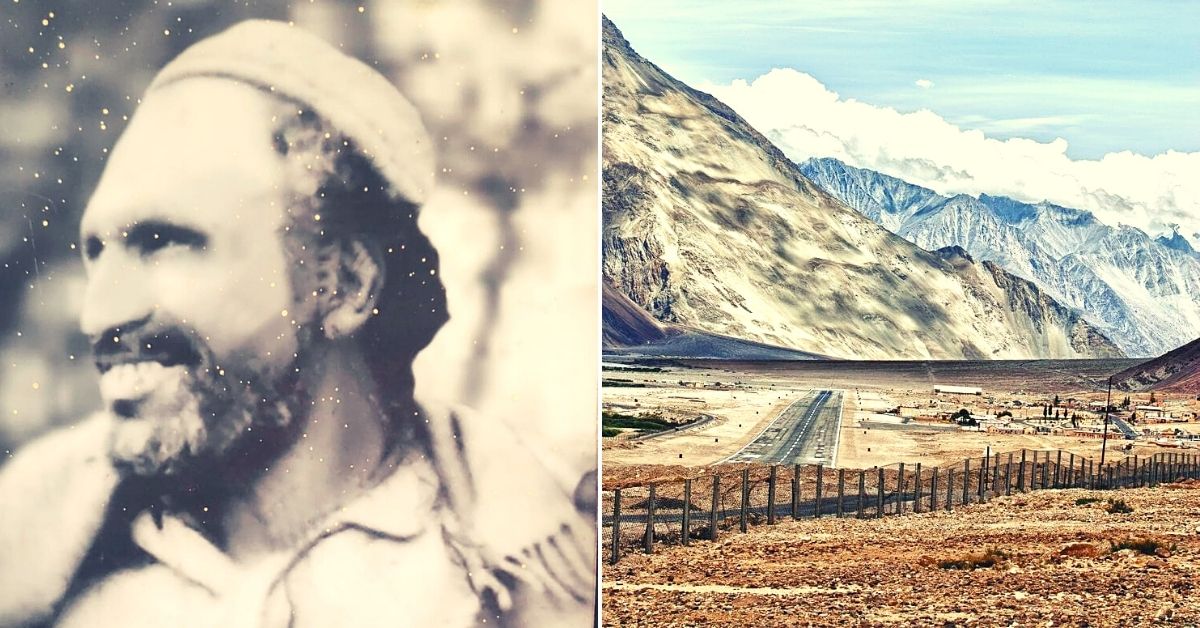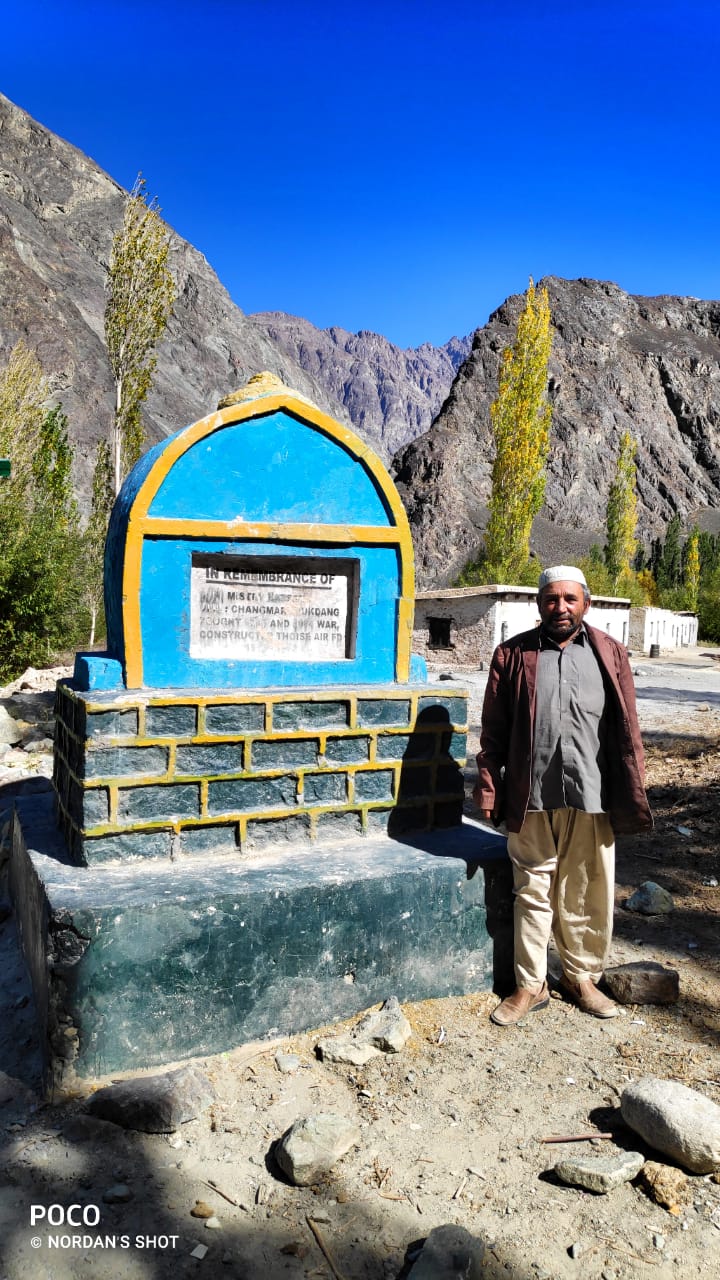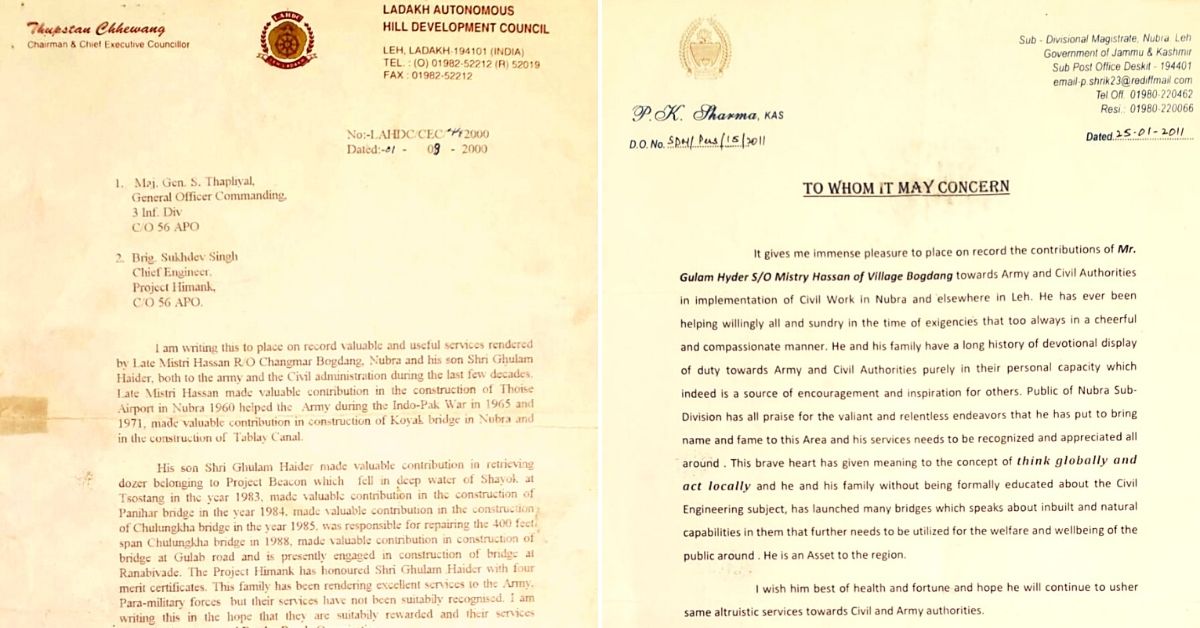Exclusive: This ‘Untrained’ Ladakhi Mason Helped The Indian Air Force Defend Siachen, Nubra
Without the ingenuity of Ghulam Hassan, a mason, there would be no THOISE (Transit Halt Of Indian Soldiers Enroute-to Siachen) airbase.

(This is the first of a two-part series chronicling the remarkable life of Mistry Hassan, a mason, whose contributions to India and Nubra shouldn’t ever be forgotten.
Without the ingenuity of Ghulam Hassan, a mason and casual labourer from Bogdang village in Nubra Valley, Ladakh, and the industry of more than 500 Ladakhi workers in 1961, there would be no THOISE (Transit Halt Of Indian Soldiers Enroute-to Siachen) airbase.
(Photo above: Left – Mistry Hassan, Right – THOISE airfield.)
It’s the airbase from where the Indian armed forces send soldiers and critical supplies to those posted in Siachen and other important border outposts in the region.
So, how did it all happen?
Towards the end of 1960, KD Menon, the Assistant Commissioner overseeing the administration of Nubra Valley, Ladakh, called a meeting of the local administration and members of civil society. Officers like Menon were from the Indian Frontier Administrative Service (IFAS), a separate cadre of civil servants created in 1954 to administer the erstwhile North-East Frontier Agency (NEFA) and other frontier regions.
One of the issues discussed during the meeting was the lack of an airfield which could help supply material and goods to soldiers posted at the border – much indeed needed since the Nubra Valley shares a border with Pakistan and China.
It was decided that one resident from each of the approximately 500 families in the region would volunteer their labour to help construct it.
Before construction commenced in April 1961, three locations were shortlisted at first–a flat land called Chilling near Digger village, a plot of land near Disket village and another piece of flat land between Skampuk and Terchay village called Mala-ling.
In stepped Ghulam Hassan (aka Mistry Hassan), who led his fellow workers in suggesting to the Indian armed forces that it would be best if the airfield was not built in the proximity of villages. Taking their concerns on board, the airfield was built on the flat land called Mala-ling because it wasn’t close to any village, and today that’s where THOISE stands.
Born sometime in the 1920s in Udmaru village, Nubra, Hassan grew up in an agrarian household living with five sisters and two brothers. A member of the Balti ethnic community, his ancestors were from Thagas village, which is today located in Gilgit-Baltistan province of Pakistan. When he was a young boy, his family had to move from Udmaru to Bogdang village because of tensions with the Buddhist residents.
When the family made their way to Bogdang, Hassan first found work as a servant of a wealthy family. However, over time, he developed skills in masonry work, carpentry and established a reputation for high intelligence despite his lack of formal education. According to his son Ghulam, even the local Tehsildar and Indian Army officers would consult him on certain projects. Despite his humble beginnings as a servant in a wealthy household. He soon made enough to acquire land for himself in Bogdang village.

Before construction commenced, the local administration air-dropped hundreds of pickaxes and shovels to a village from where they were loaded onto mules, horses and yaks. But when construction began, there was another problem.
The soil on the site chosen for the airfield was tough and slippery because of the high clay content in the soil which had solidified and held rocks below the surface tightly. Workers found it nearly impossible to dig through. Hassan Mistry found another innovative solution.
According to ‘A Guide to Nubra Valley’ written by a former government school teacher and author Haaji Abdul Razzaq Jamshed, who witnessed these events, Hassan Mistry had “suggested the digging of a canal to connect the Beyaklong stream [a few miles away from the proposed airfield] to the ground.” In the book, Jamshed goes on to add “The melting snow brought water to the stream in April and May, and the canal will bring it to the ground; the wet soil then makes the work of digging and levelling that much easier.”
Initially, the other workers weren’t happy with Hassan’s suggestions since it meant more work, but once the 2 km-long canal was constructed, digging through the wet soil with pickaxes and shovels became much easier. The work of digging the soil was done under moonlight since the mid-day sun in July and August is harsh.
“Ditches were dug, and rocks that could not be moved were then manhandled into these ditches and the surface levelled. Huge rocks were blasted by the young men of the village who would cut holes through the rock, fill them with explosives and shatter them,” notes Jamshed. Nearly 500 workers showed up for work every day. In appreciation for their contribution, the armed forces began to airdrop wheat grain (15 kg per head) and unrefined sugar (1 kg per head), which was then distributed as a ration for the workers.
“The next obstacle was how to flatten the surface as there were no roller machines. My father went to nearby villages in search of the two biggest apricot trees and found them. He chopped these trees and converted them into rollers by inserting iron rods in the holes my father and Chemet Namgyal, a carpenter, had drilled through the length of these tree trunks,” says Hassan’s son Ghulam Haider, who is popularly known in the region as Nathroo, in an exclusive conversation with The Better India (TBI).

These rollers were pulled by nearly 20 men each through ropes tied to the end of the rods. On 1 October 1961, the first plane landed on the ready-to-use airfield handed over to the Indian armed forces by residents of Nubra. This airfield has since been used as a facility which enables a quick inflow of men and material from the Indian mainland to Siachen.
“Moreover, my father made an interesting suggestion to senior political leaders of Nubra, which entailed signing an agreement with the Indian government. The agreement would state that since the people of Nubra provided the land for the airfield, it should be registered under the local civilian administration there. I believe an agreement was signed, but it was later objected to by the Indian Air Force and modified by local authorities without consulting community leaders. Instead, the people of Nubra have been given the privilege to travel in army aircraft from THOISE to Chandigarh for meagre airfare (INR 1,150) as a mark of gratitude by the Government of India,” says Ghulam.
“Without THOISE, India may have lost Nubra Valley to China in 1962. Chinese troops had advanced over Indian forces in the DBO sector and Chushul region, capturing Rezang La with thousands of casualties on either side. Many brave young civilians from Nubra valley were taken in an aircraft from THOISE and airdropped in DBO to defend Ladakh.” notes Tsewang Dorjey Dongbos, who served as Nubra’s Assistant Commissioner (civil administration) for many years, speaking to TBI.
“While the war was going on, the civil administration under the supervision of officers such as KD Menon was engaged in building roads for the Indian Army. Mistry Hassan was given the responsibility of supervising the construction of these roads on the ground. His contributions to protecting Nubra from the Chinese invasion was enormous. We should remember him as among the saviours of Nubra Valley and deserves a lot more recognition than he is getting today,” Tsewang adds.
The airfield would go on to play a significant role in assisting the Indian armed forces during the 1965, 1971 and 1999 wars against Pakistan.
“He was gifted with remarkable intelligence. I remember on one occasion when a Dakota military transport aircraft had a technical problem and couldn’t take off for days from THOISE. Many qualified engineers attempted to fix it but in vain. Finally, Hassan obtained permission from the concerned authorities if he could try his hand. It was unbelievable that he managed to fix it. The Dakota soon flew back to Pathankot,” says Tsewang.

Two citations: On the left, it’s a letter from Thupstan Chhewang, former Chief Executive Councilor of Leh Autonomous Hill Development Council and Member of Parliament. On the right, we have a letter from former SDM of Nubra PK Sharma.
Having said all this, there was a lot more to Hassan’s world, which we will explore along with how his son Ghulam carried his legacy further in the next part of this two-part series.
(With valuable inputs and photos courtesy Dr Nordan Otzer.)
(Edited by Vinayak Hegde)
Like this story? Or have something to share? Write to us: [email protected], or connect with us on Facebook and Twitter.
If you found our stories insightful, informative, or even just enjoyable, we invite you to consider making a voluntary payment to support the work we do at The Better India. Your contribution helps us continue producing quality content that educates, inspires, and drives positive change.
Choose one of the payment options below for your contribution-
By paying for the stories you value, you directly contribute to sustaining our efforts focused on making a difference in the world. Together, let’s ensure that impactful stories continue to be told and shared, enriching lives and communities alike.
Thank you for your support. Here are some frequently asked questions you might find helpful to know why you are contributing?


This story made me
-
97
-
121
-
89
-
167













